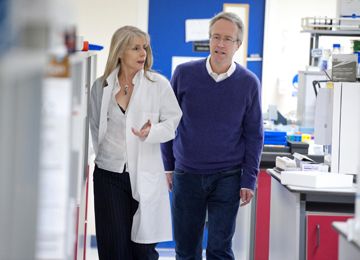The Human Brain Project is humanity’s newest and most introspective foray into big science. Like America’s BRAIN initiative, this European project aims to unravel the mysteries of the mind to better understand and combat brain disease. But while U.S. researchers focus on developing new brain-probing technologies, hundreds of scientists throughout Europe are working with existing tools to construct a complete computer model of the human mind.
The European project is the billion-dollar brainchild of Henry Markram, a visionary neuroscientist who handpicked a small group of experts to orchestrate the work. Seth Grant, one of those leaders, may seem an unlikely selection. The project's proponents tout it as the marriage of modern biology and technology, emphasizing the latter with cutting-edge buzzwords like neurorobotics and neuroinformatics. Grant, however, speaks mostly of mice and molecules.
Grant, a neuroscientist at the University of Edinburgh in Scotland, studies how protein machines in the brain organize, maintain, and help relay signals across neural junctions called synapses. Getting at these proteins—and their role in health and behavior—is difficult in humans. Fortunately, the human brain is remarkably similar to that of a mouse. By tweaking the structure of brain proteins in mice, Grant and his team measure how they influence cognition. They’ve shown that faulty proteins play a role in over 100 neurological disorders, including schizophrenia. As part of the Human Brain Project, Grant hopes to provide the molecular foundation for a computer model that can explain these maladies.
Grant discussed how real molecules from mice fit into the virtual model for human brains at the February 2014 meeting of the American Association for the Advancement of Science in Chicago. He rewarded SciCom’s Matt Davenport with a big-picture interview afterward.
How did you get involved with the Human Brain Project?
Through knowing Henry [Markram]. We were both presenting at a meeting at NYU [New York University] in 2008 or 2009. Both of us gave big-picture scientific talks with huge data sets and interesting new approaches. We were in a taxi and talking about how this is the way forward, as opposed to ultra-small-scale studies. We obviously shared some common views.
So timing was an important part of it. Why is now the right time?
Well, there have been advances in neuroscience in the last 10 years at several levels. At the level of molecular biology, this idea that you can look at all genes, the whole genome, and all proteins, the whole proteome, is based on the capacity to sequence genes and detect proteins. This is a major step forward, and it has enabled all kinds of important new science.
How does the Human Brain Project compare to the BRAIN initiative in the U.S.? Is there collaboration or competition?
The Human Brain Project is centered around computational platforms and strategically collected data. The BRAIN initiative is promoting the development of new technologies for acquiring data on the brain. Data collected by the BRAIN initiative will be integrated into the Human Brain Project—there is collaboration. There is no sense of competition because they are organized differently and have different ambitions.
What are the ambitions of the Human Brain Project?
People will be defining simulations [of the brain] based on mathematical algorithms—from real measurements and assumed measurements.
Assumed measurements?
For models of the human brain, you could take the following two views. One is to say, “I'm going to measure every parameter in every cell and every molecule, then put all those parameters into an equation. Then I'll have a model of the brain.” Now, somebody will just say, "Hang about. You'll never make all those measurements. That'll take a million years." And, of course, you'll have to agree.
The second approach is to identify key principles and constraints, and then extend them across areas where you have not been able to make measurements. You use those constraints to make assumptions. There are all sorts of constraints in biology. Not everything is possible.
Does your work with mouse proteins help identify constraints?
Yeah, they have very specific molecular constraints. Proteins, like Lego blocks, can assemble into bigger structures, complexes, and even bigger structures, supercomplexes—sort of complexes of complexes. But it's not a promiscuous system. If something's made of 20 proteins, you can't just stick together any 20 proteins. There are molecular constraints to how proteins assemble.
"All you’re really doing is rewarding the mice for touching the screen with their noses when they see the right thing. It’s very lovely."
But it’s the Human Brain Project. Why are you studying mice?
Rodents and humans shared a common ancestor about 100 million years ago. You will find that many of the brain proteins—particularly those in synapses—are exceptionally well-conserved, meaning the sequences haven’t accumulated many mutations to change them over that 100-million-year period. Natural selection has maintained those genes.
Part of me doesn’t want to believe my brain is so similar to a mouse's.
I think one has to look at it in a historical way. Obviously, at some point, people knew nothing about the organization of the brain and only looked at various aspects of behavior. Putting that aside, the neuroanatomists of the last century identified homology, similarity, between all sorts of different mammalian and other vertebrate brains. The full genomes of many, many species have been sequenced. We know which genes are expressed in the brains of different species. We can compare the differences in the gene sequences, and one of the most striking aspects is the extraordinary similarity among many species.
And now, through your work, you’re starting to realize that they’ve all got these big proteomic. . . .
Protein machines. Yeah.
I like to think of the brain as a computer. If that’s a good analogy, where do these machines fit in?
I think the computer analogy has some merit. But when I think about how the computer of the brain is built, we need to move beyond the standard model that computation is only done at the cellular and circuit level [neurons and their connections]. The brain is a hierarchy of strictly organized components spanning genes, proteins, synapses, circuits. At each of these levels there are computational properties. Synapses contain hundreds of proteins assembled into molecular machines. They perform highly complex and sophisticated computations.
What happens if there’s a glitch in our protein machines?
Impairments in supercomplexes interfere with synapses and, thus, circuits. Mutations in these [proteins] result in cognitive functions.
Or dysfunctions?
In our work on the proteome—that is, identifying the proteins—we’ve always tried to relate that to disease. It has become clear that all of the postsynaptic proteins are very important in human disease. There are over 130 brain diseases caused by mutations in over 300 genes encoding these. This set of proteins is responsible for more brain diseases than any other proteins we know about in the brain.
You’ve found that one of those diseases is schizophrenia. Can mice be schizophrenic?
Some mice carry the same human mutations known to cause schizophrenia. Those mice have been tested in psychology tests of the same types done by humans, and they seem to have quite similar deficits. By that criterion, they are showing the cognitive impairments and genetic causes of schizophrenia. There’s no reason to suppose that schizophrenia is a human-only disorder.
What does a psychological test for a mouse look like?
You give them various sorts of tests. Using these touch screens, which I think are state-of-the-art these days, we can present different images. You reward them for paying attention to the correct image by touching it with their nose. You give them a little snack.
You can test simple forms of learning, complex forms of learning, various sorts of attentional tasks. You can probe many components of behavior with this test apparatus. All you’re really doing is rewarding the mice for touching the screen with their noses when they see the right thing. It’s a very lovely thing.
I’m imagining mice nuzzling iPads.
They’re not iPads, but screens with specialized sensitive surfaces. They are, in principle, the same.
Has anything surprised you about your studies, particularly in how mice and humans compare?
The fact of the matter is mice are not humans. There are going to be some subtle differences.
I wouldn't be surprised if some [experiments] turn out where the mutation in the mouse doesn’t do much, but in the humans it does something. That would mean this particular mouse model would not be a good one for testing drugs for human disease. I think this can have a really big impact on the way drug testing is going to be done in the future.
Neuroscientists also talk about the differences that make the difference—the things that make mice and humans different despite their genetically similar brains. If you observe those distinct behaviors, does that give you a clue about the important differences?
It does. It certainly does. That’s why if one were to test many different gene mutations in mice and in humans, we would begin to accurately, quantitatively, unambiguously measure the genetic architecture of cognition in the two species.
We’ve already touched on how looking one molecule at a time would take ages. Do you have goals for the Human Brain Project’s more immediate future?
Using mice that carry specific mutations, where we know they have cognitive impairments, we're going to try build some sort of computer-simulation robot. If it behaves like a living mouse, we can then ask if a mutation in silico [a mutation simulated in the computer model] results in the robot mouse behaving like a living mutant mouse. This would show that our simulation is valid.
If the model is valid, what's the next step?
Our initial models would be based on a subset of genes and proteins. It wouldn't be the whole genome. It would be a fairly elementary model by comparison to the real animal. But that doesn't matter because we would be establishing the ability to do this kind of work. So then, we'd give [the robot mouse] more molecules and new genes. Those genes could be relevant to new types of diseases.
Will you be able to build that simulated mouse in the ramp-up phase?
I think that's unlikely in the current funding period, but maybe the second.
So 10 or 15 years?
I don't see any reason why we couldn't have a shot at that within five years.
____________________
© 2014 Matt Davenport
Read about Matt and his work here: mrmattdavenport.com


